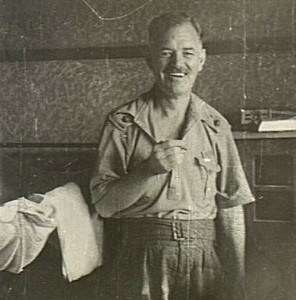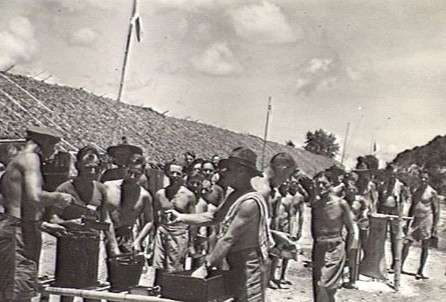First to Fight
2/3rd Reserve Motor Transport
Company AASC
As tensions rose with Japan in the Pacific in 1941, the British Government looked to defending its Singapore base, and its protective Malay Peninsula hinterland, without detriment to the Middle East theatre or Home defence. A GHQ Malaya appreciation in January 1941 correctly predicted the landing places of a Japanese invasion: contingency plans were prepared and slow build-up of forces to implement these plans began. As part of this build-up, the 8th Australian Division and its supporting corps troops slice began to arrive from February, and Indian Army formations were also progressively shipped in.
With the consequent inflow of equipment and supplies, a shortfall developed in motor transport. The UK requested the Australian government to help with this, and as existing AIF assets were committed to the build-up of 1st Australian Corps in the Middle East, two special transport companies and two motor ambulance convoys were raised to help fill the gap. One of these, 2/3 Res MT Coy, was filled with men in the 35-45 age group, many of whom were World War 1 veterans who understated their age to get in under the ceiling. As they were intended for employment on dock clearance in Singapore, this ageing membership was not considered a handicap, particularly given their previous military experience.
2/3 Res MT Coy was raised from Queenslanders and New South Welshmen at Liverpool in early 1941 under command of Maj C.M. Black, with a strength of over 400. The main body embarked on HMT Orcades for Singapore on 11 April, arriving on 24 April. It was initially based in Johore State, where it began in-theatre training and was progressively equipped with vehicles. From 3 June it began movement by rail to Ipoh in northern Malaya, commencing transport tasks on the 15th. Routine tasks, continuing its vehicle buildup, and progressive training continued through to October, when the unit was augmented by having half of Chinese
Res MT Coy placed under command.
So this unit recruited for base deployment, due to the dearth of competent transport units, found itself deployed in support of 11th Indian Division in the far north of the Malay Peninsula in a variety of forward roles including ammunition, petrol and food resupply, and troop lifts. On 7 December orders were received to adopt 1st degree of readiness, and to open fire on aircraft ‘not established as friendly’.
In anticipation of a Japanese landing at Patani in Thailand, Krohcol force was established to intercept and hold them at The Ledge, a pass on the Thai side of the border. When the landing was confirmed on 8 December, two platoons under Capt G.A.C. Kiernan moved 3/16 Punjab Bn to the pass, however the deployment was too late to seize The Ledge, and the battalion was outflanked. The spare drivers dismounted and fought to help extricate the unit, which was then withdrawn in Company vehicles. This detachment was the first Australian Army unit in action, a month before the first AIF infantry unit saw action at Gemas over a month later 1. As well as continuing its transport tasks, it provided machine gun patrols and an anti-paratroop force for aerodrome protection.
With the fluidity of operations in northern Malaya, and enemy outflanking moves threatening the lines of communication, GOC 3rd Indian Corps tasked the Company Commander to draw armoured cars from depot and form an armoured car company to counter an enemy breakthrough along the Grik road. The Company was kept busy moving supplies, fuel and ammunition, manning ferries whose crews had deserted, and redeploying brigades. In addition, a major task was moving battalions to new defensive positions, and withdrawing them under mortar and machine gun fire and air attack. One War Diary entry records ‘the whole morning … under LMG fire’.
This pattern continued in the rolling withdrawal down the Malay Peninsula, until on 15 January 1942 the unit was transferred from 11th Indian Division to 8th Australian Division, which was at last being relieved of protection duties and establishing a new line of defence in southern Malaya. This line, after initial successes, contracted towards Johore with eventual evacuation of the Malay Peninsula. The Company was kept busy evacuating formations to Singapore and was itself finally concentrated there on 31 January 1942.
The Company worked ‘with every brigade fighting in western Malaya’, drawing accolades from them on the unit’s fearless efforts to rescue infantrymen from being overwhelmed in the fast-moving withdrawal down the Peninsula; one British officerasserted that ‘without them we would have lost thousands of men’. Its final task of the campaign was to help move the main body of 8th Division across the Causeway from Johore to the last stand in Singapore. In view of the constant exposure to air and ground attack, it had suffered the remarkably low casualties of six killed and 10 wounded, due largely to its members’ training, competence, audacity and commitment.
Thereafter, the unit was loaded on the Kinta, manning the ship after the crew deserted, and sent to Java to join the intended 1st Australian Corps to be formed in Java from the 6th and 7th Divisions returning from the Middle East. In fact the divisions did not arrive in time, and 2/3 Res MT Coy became part of a scratch brigade designated Blackforce, which was soon run down in the Japanese invasion of Java after Dutch resistance collapsed. It was surrendered by higher command on 8 February and imprisoned in the Bicycle Camp at Batavia, where it remained under increasingly brutal conditions until moved to Singapore in early October 1942.
The move to Singapore was the first step in its move to Burma to join A Force, for employment on the Burmese section of the Thai-Burma railway where it arrived at the end of October 1942. Whilst subjected to the usual brutal and callous treatment at the hands of its captors and taskmasters, the able commander of A Force, Brig A.L. Varley was strong enough to ameliorate the worst excesses, in marked contrast to the Thai sector of the rail work. Their losses in this task amounted to a ‘mere’ 15 percent; and although there were fears that the overage men of 2/3 Coy, some approaching fifty, would fare badly under the same working conditions as men in their twenties, the reverse was the case.
The Burma section was effectively completed by the end of 1943, and A Force was moved to base camps in Thailand by January 1944. During that year, prisoners were dispersed to Changi, Saigon, Japan and Borneo as workers, or deployed on local maintenance tasks until the end of the war in August 1945. Those in the Thai and Singapore camps were taken into custody and care of No 2 Australian Prisoner of War Reception Group, and when able to travel, flown to Singapore for repatriation to Australia.
Footnote
1. Coincidentally, the first Australian Army unit in action against the Communist Terrorist forces in Malaya was Lt Tony Hall’s 126 Tpt Pl, which broke a CT ambush on the Ipoh-Cameron Highlands Road in December 1955, before 2 RAR began operations early the following year.


